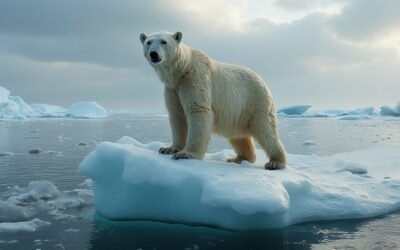Arctic hares contend with several natural predators that influence their population and behavior. Key enemies include Arctic foxes, known for their acute hunting senses, and red foxes, which use stealth and agility. Grey wolves hunt in packs, employing sophisticated strategies. The Canadian lynx is another formidable predator, utilizing its agility. Ermines, with their slender bodies, are adept at chasing hares into tight spaces. Birds of prey, such as eagles and owls, rely on their keen vision to capture hares. Finally, humans impact hare populations through hunting and climate change. Understanding these dynamics deepens our knowledge of Arctic ecosystems.
Main Points
- Arctic foxes rely on acute senses and hunting skills to prey on Arctic hares.
- Red foxes use stealth and agility to hunt Arctic hares, adapting strategies seasonally.
- Grey wolves employ pack hunting tactics to capture Arctic hares.
- Canadian lynx utilize stalking and ambush techniques to prey on Arctic hares.
- Ermines hunt Arctic hares by chasing them into tight spaces and using sharp teeth.
Arctic Foxes
Arctic foxes are formidable predators of Arctic hares, utilizing their acute sense of smell and hearing to effectively hunt and capture their prey. These small yet resilient mammals play a pivotal role in the Arctic ecosystem, where their predation activities greatly influence the population dynamics of Arctic hares. As natural predators, Arctic foxes rely heavily on the abundance of Arctic hares for their survival in the harsh and frigid environment of the Arctic.
The Arctic fox's adept hunting skills allow it to locate and track its prey even under thick layers of snow. This predation is not merely a survival mechanism for the foxes but also an essential component in maintaining the balance of the ecosystem. By controlling the populations of Arctic hares, Arctic foxes help prevent overgrazing of vegetation, which can lead to broader ecological consequences.
In essence, the hunting and predation behaviors of Arctic foxes contribute to the stability and health of the Arctic ecosystem. Their role as natural predators guarantees that neither prey populations nor plant life become disproportionately large, hence fostering a balanced and sustainable environment. This equilibrium is crucial for the overall integrity of the Arctic habitat.
Red Foxes
Red foxes, as primary predators of Arctic hares, exhibit distinct predatory behavior patterns that greatly impact hare populations. Utilizing keen senses and stealth, red foxes employ sophisticated hunting techniques to track and ambush their prey. The seasonal variations in their predation strategies further influence the survival rates of Arctic hares, underscoring the importance of understanding these dynamics within the ecosystem.
Predatory Behavior Patterns
Exhibiting remarkable adaptability, foxes employ a combination of stealth, speed, and keen sensory perception to hunt Arctic hares effectively. Red foxes (Vulpes vulpes) are skilled predators with highly developed hunting abilities, allowing them to tackle a variety of prey, including the elusive Arctic hare. Their predatory behavior is characterized by a strategic blend of patience and agility, which enables them to successfully capture their quarry.
Red foxes possess acute hearing and a keen sense of smell, key adaptations that greatly enhance their ability to detect the presence of Arctic hares. These sensory skills enable the foxes to locate their prey even in challenging Arctic environments. Once a potential target is identified, red foxes demonstrate impressive speed, capable of reaching up to 48 km/h, which is essential for closing in on the swift and agile hares.
Moreover, their intelligence and adaptability play a pivotal role in refining their predatory tactics. Red foxes are known to modify their hunting strategies based on various environmental factors to maximize their success rate. This versatility in predatory behavior underscores the red foxes' role as formidable natural enemies of Arctic hares, showcasing their remarkable adaptations and hunting prowess.
Hunting Techniques Employed
Employing a range of sophisticated hunting techniques, foxes leverage their keen sense of smell, agility, and intelligence to successfully capture Arctic hares in the challenging tundra landscape. In the snowy tundra, red foxes utilize their acute olfactory senses to detect the presence of Arctic hares, even when they are hidden beneath layers of snow.
These predators exhibit remarkable agility and speed, capable of reaching up to 50 km/h to chase down their prey. Their hunting techniques often involve stealthy stalking, where they stay low to the ground and move with calculated precision to approach unsuspecting hares. This stealth allows them to close the distance without alerting their prey, enhancing their chances of a successful hunt.
Upon nearing their target, red foxes rely on their sharp teeth and strong jaws to deliver a fatal bite to the neck or head of the Arctic hare. Their adaptability and intelligence enable them to employ a combination of these hunting strategies effectively. By integrating these varied techniques, red foxes have become proficient predators, skillfully maneuvering the harsh conditions of the snowy tundra to secure their food sources.
Seasonal Impact on Predation
Seasonal changes significantly influence the predation behavior of red foxes, with varying success rates in hunting Arctic hares throughout the year. During the summer months, the Arctic landscape undergoes a transformation that leaves Arctic hares with brownish-gray fur, making them more visible against the thawed terrain. This seasonal impact notably increases the predation success rate of red foxes, who can more easily spot and hunt their prey.
Conversely, the winter season presents a different challenge for red foxes. The white fur of Arctic hares blends seamlessly with the snow-covered environment, providing effective concealment against predators. This seasonal adaptation reduces the predation efficiency of red foxes, forcing them to rely on their keen senses and opportunistic hunting strategies. During this period, red foxes may target young or weak Arctic hares, which are less skilled at utilizing their camouflage or evading predators.
The relationship between red foxes and Arctic hares exemplifies the dynamic nature of predator-prey interactions in the Arctic ecosystem. The seasonal impact on predation highlights the adaptive strategies employed by both predators and prey to survive in this harsh environment. Understanding these dynamics is essential for comprehending the broader ecological balance within the Arctic region.
Grey Wolves
Grey wolves, as one of the primary predators of Arctic hares, employ sophisticated hunting strategies and teamwork to capture their prey. These natural predators are adept at maneuvering through the harsh conditions of the Arctic tundra, where both species reside. Grey wolves exhibit remarkable agility and keen senses, which enable them to efficiently track and catch Arctic hares. The predation by grey wolves plays a significant role in shaping the population dynamics of Arctic hares within their shared habitat.
Grey wolves primarily hunt in packs, which enhances their ability to outmaneuver and isolate their prey. Their hunting methods include:
- Cooperative hunting: Wolves work together to encircle and corral Arctic hares, reducing the chance of escape.
- Ambush tactics: Utilizing the element of surprise, wolves can effectively close in on unsuspecting hares.
- Endurance pursuit: Wolves are capable of long-distance chases, wearing down their prey over time.
The presence of grey wolves can significantly influence the numbers and behavior of Arctic hares. When wolf populations are high, hare numbers often decline, demonstrating the predator-prey relationship that underscores the ecological balance within this environment. Grey wolves, through their hunting practices, maintain the natural order, ensuring the health and sustainability of their ecosystem.
Canadian Lynx
Canadian lynx are formidable predators of Arctic hares, utilizing their agility and keen senses to effectively hunt in their rugged environment. Their hunting strategies, characterized by stealth and precision, play an essential role in their interactions with Arctic hares. This predator-prey relationship notably influences the population dynamics of both species, illustrating the interconnectedness of the Arctic ecosystem.
Hunting Strategies and Techniques
Renowned for their exceptional hunting prowess, lynxes employ a combination of stalking and ambush tactics to capture Arctic hares. The Canadian lynx leverages its agility and stealth to silently approach its prey, utilizing sharp eyesight and acute hearing to detect subtle movements. These adept hunters demonstrate remarkable patience, often waiting for the perfect moment to launch a precise, powerful attack.
Canadian lynx hunting strategies are characterized by several key techniques:
- Stalking and Ambush: Lynxes carefully stalk their prey, maintaining a low profile to avoid detection before initiating a sudden, explosive ambush.
- Agility and Stealth: Their nimbleness and quiet movement enable them to navigate through dense vegetation without alerting potential prey.
- Prey Detection: The lynx's heightened senses allow it to detect even the slightest rustle or movement, making it an efficient predator in the challenging Arctic environment.
Once within striking distance, the lynx relies on a burst of speed and the element of surprise to capture the elusive Arctic hare. Its sharp retractable claws and powerful jaws guarantee that once the prey is caught, it has little chance of escape. These refined hunting strategies highlight the Canadian lynx's role as a formidable natural enemy of the Arctic hare.
Lynx and Hare Interactions
The intricate interactions between lynx and Arctic hares exemplify the delicate balance of predator-prey relationships in Arctic ecosystems. Canadian lynx are primary predators of Arctic hares, and their populations are closely intertwined. This predator-prey dynamic is a classic example in ecological studies, highlighting how fluctuations in hare population densities directly influence lynx numbers.
Lynx, with their specialized hunting adaptations, are adept at preying on Arctic hares. Their keen senses, agility, and stealth enable them to effectively hunt these elusive creatures, particularly during periods when hare populations are abundant. The reliance on Arctic hares as a primary food source means that lynx population densities tend to rise and fall in response to the availability of hares.
During times of high hare abundance, lynx thrive and reproduce more successfully, leading to an increase in their numbers. Conversely, when hare populations decline, lynx face food shortages, which can result in decreased survival and reproduction rates. This cyclical pattern underscores the importance of Arctic hares in the ecosystem and the adaptive strategies lynx have developed to exploit this resource.
Understanding these predator-prey dynamics provides valuable insights into the broader ecological interactions and the balance necessary for maintaining healthy Arctic ecosystems.
Ermines
Ermines, also known as stoats or short-tailed weasels, are adept predators that pose a notable threat to Arctic hares. These small carnivores possess slender bodies, sharp teeth, and remarkable agility, making them efficient hunters in the harsh Arctic environment. Ermines exhibit a fur color adaptation that allows them to change their coat seasonally; they sport white fur in winter to blend seamlessly with the snowy landscape, providing them with an essential advantage in stalking their prey.
Ermines are particularly efficient at exploiting the vulnerabilities of Arctic hares. They often chase their prey into burrows or dense vegetation, areas where Arctic hares might seek refuge but may not escape the relentless pursuit of these determined predators. Their voracious appetites and hunting prowess can notably impact local hare populations.
- Physical Adaptations: Ermines have slender bodies and sharp teeth, which aid in their hunting efficiency.
- Behavioral Tactics: They are known for chasing prey into tight spaces where escape is difficult.
- Seasonal Fur Changes: Their fur changes to white in winter, allowing them to blend with snowy environments.
Birds of Prey
In addition to ermines, Arctic hares face significant predation pressure from various birds of prey, including Rough-legged Hawks, Peregrine Falcons, and Gyrfalcons. These formidable avian predators employ their keen eyesight and powerful talons to hunt and capture Arctic hares, making them a constant threat in the tundra ecosystem.
Rough-legged Hawks are known for their exceptional vision, allowing them to spot hares from great distances. Peregrine Falcons, celebrated for their incredible speed, can dive at astonishing velocities to snatch their prey. Gyrfalcons, the largest of the falcon species, leverage their strength and agility to overpower Arctic hares. Additionally, Snowy Owls also contribute to the predation of Arctic hares, particularly during the breeding season when food demand is high.
Arctic hares have developed adaptive behaviors to evade these aerial threats. Utilizing their remarkable speed and agility, they often engage in zigzag running patterns to escape the grasp of their airborne predators. This dynamic interplay between Arctic hares and birds of prey is essential in maintaining the balance within Arctic ecosystems. Predatory birds play a pivotal role in regulating Arctic hare populations, ensuring ecological stability and biodiversity conservation in these harsh environments.
Humans
Humans pose a significant threat to Arctic hares through hunting, commercial exploitation, and environmental changes induced by climate change. Historically, Arctic hares have been hunted for their fur, meat, and as sport, significantly impacting their populations. Indigenous communities also hunt these hares for subsistence purposes, adding another layer to the human-induced pressures they face.
The commercial exploitation of Arctic hares for their fur has further exacerbated these threats. Although less prevalent today, the fur trade once played a considerable role in diminishing hare populations. Additionally, climate change driven by human activities is altering Arctic habitats, leading to habitat destruction and making survival more difficult for these animals.
In response to these threats, conservation efforts have been implemented to protect Arctic hares from human-related dangers. These efforts encompass a range of strategies aimed at sustaining hare populations and mitigating human impact.
- Regulation of hunting practices: Implementing strict hunting regulations to prevent overhunting and allow populations to recover.
- Habitat preservation: Protecting critical habitats from development and environmental degradation.
- Climate action: Addressing broader climate change issues to ensure the long-term viability of Arctic ecosystems.
These combined efforts are essential for safeguarding the future of Arctic hares amidst their natural enemies.
What Are the Most Common Natural Predators of Arctic Hares?
Arctic hares have adapted to survive in harsh environments, but they must constantly watch out for predators hunting arctic hares. Common natural predators include Arctic foxes, wolves, and snowy owls, which rely on their keen senses and speed to catch these nimble creatures in the snow-covered tundra.
Why Do Arctic Hares Have So Many Natural Enemies?
Arctic hares have many natural enemies because their harsh environment sustains limited food sources, making them a target for various carnivores. The scarcity of vegetation means arctic hares and predators are both fighting for survival, with hares being prey to foxes, wolves, and large birds such as snowy owls.
Conclusion
The Arctic hare faces a multitude of natural predators, which include Arctic foxes, red foxes, grey wolves, Canadian lynx, ermines, various birds of prey, and humans. These predators pose significant threats to the survival of the Arctic hare, influencing its behavior, population dynamics, and habitat use. Understanding these natural enemies is essential for the development of effective conservation strategies aimed at preserving the delicate balance of Arctic ecosystems.


